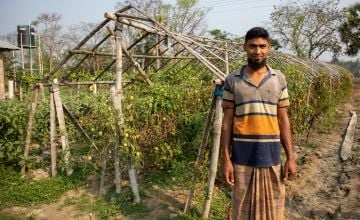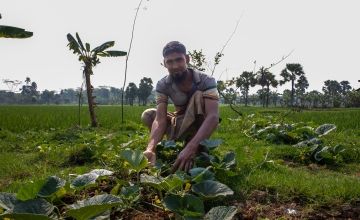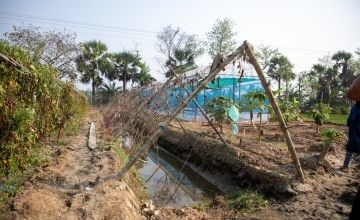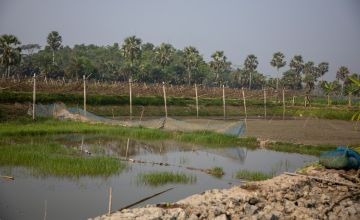
Knowledge Hub
In southern coastal Bangladesh lies a district called Bagerhat. Here resides a 25-year-old young man called Esanuel. However, Esanuel is not your typical 25-year-old. He is an advanced level agriculture entrepreneur and a lead farmer looking after 120 other farmers, leading the way to the future of climate smart agriculture.
In early 2020, Esanuel had finished school and was trying to think about what he wanted to do for a living, but could not find a job that he wanted. After some time, he began to think he would like to grow vegetables to earn a living and help his community.
Esanuel began communicating with an agriculture officer who introduced him to Concern’s ‘Collective responsibility, action and accountability for improved nutrition’ (CRAAIN) project. By late 2020, Esanuel had enrolled on to the programme.
Initially, Esanuel received a variety of training: "I learnt from the CRAAIN project different training, climate smart agriculture techniques and also the vermicompost technique; how to make vermicompost and use it in cultivation. There were also other kinds of training focusing on nutrition and what kind of foods should be eaten for their nutrition value.”
[Vermicompost is similar to traditional compost, but uses various species of worms to create a mixture of decomposing vegetable or food waste.]

To date, Esanuel has received two lots of training, in 2020 and 2022 respectively and has graduated to an advanced level agriculture entrepreneur. Now, he provides training to others and looks after 120 other aspiring entrepreneurs.
People come here to visit and see my field and they learn and they ask me and I tell them what was the technique. They can come anytime to me and I can support them with the good techniques, information and knowledge.
The climate smart techniques bringing success in challenging contexts
Bangladesh is particularly vulnerable to climate change and natural disasters making it difficult for people to grow vegetables and other crops. In the coastal area where Esaneul lives, Bagerhat, saline water is a big issue.

This is our community but saline water is a huge problem, and every time there is a flood or another disaster happens it worsens.
Esanuel explains how climate change has exacerbated this. Previously, the challenges were seasonal but now when it rains, it floods, or sometimes there is no rain at all.
“The seasons and the weather has been changing. We cannot count on the weather to do what we need it to do. The production of vegetables is relevant with the season, so when the weather and the rain is unpredictable, that is connected to the production time. So now, what we need to do is use climate smart agriculture so that we can get the production.”
Consequently, much of what Concern and Esanuel teach (and adopts in practice) are climate smart agriculture techniques.
The techniques
“What we have learnt is that we have to apply different techniques. The first is the tower technique. When you are growing vegetables going up the shed, the vegetables grow upwards and don’t go into the water. You can also grow the vegetables hanging. So the production will be from the top.”

Another technique is a floating technique (or in technical terms, the hydroponic technique), which is achieved by sowing the ground sheet under a particular bed within the water so that when the water level increases, the crop floats. Esanuel also use mounting paper, which is a paper like polythene that you put into the crop bed, protecting it from rising water.
Esanuel is also able to produce vegetables throughout the year, in a 12-month season, thanks to the techniques he learnt. He introduced this to other members of the community who have started to do this too.
Esanuel explains how he is able to do this: “If the soil is proper and is storing all the water at the right time and is right quality, then you can grow this kind of production even beyond the season.” This means he can charge more money for the produce.

Esanuel’s father used to do the cultivation on his own, but was just using regular techniques. Now that Esanuel has taken over and they work together, their focus is on climate-smart techniques producing high-yield crops and making a good profit.
“Considering all the climate-smart agriculture and high yield production, it's a huge benefit over the regular process that we followed. I am very happy and I want to take more technological advancement. So whenever I learn something, I try to apply it in my crop field and then I continue it so that I can grow more.”
As such, Esanuel is an advanced-level lead farmer. However, he did not learn all of this from Concern. Taking matters into his own hands, Esanuel watches YouTube channels to gain more understanding of different types of smart-level techniques and products.
I'm not only growing things, but I'm searching for a better way to do it. I travel to different districts for different seeds. Now I know which seed is particularly good for our mud and soil quality, so now I am growing it. I have a plan to grow the plant so that others can collect and grow it too. Previously, we didn't know this variety could be here for this particular area. But now I have introduced it.
Tackling climate change from the ground up
In addition to the brilliant climate smart techniques Esanuel uses and the success he has, he is also trying to make his farming more climate friendly.
Previously, Esanuel used chemical fertilisers, which was widely used during production. However, he learnt from the CRAAIN project about the vermicompost, which is a pure organic fertiliser, and can be used for a high yield. Now, the soil quality is better and doesn’t deteriorate as it did with chemical fertilizers. The CRAAIN project provided him with two rings and a slab for the vermicompost production.
An inspiration
Esnauel is an inspiration for people within his community and by doing his work, encourages others to do the same.
“People used to think that agriculture is for older people. But I'm young and I'm doing the same stuff so other young people would be interested in this. I dream for an agro-based industry so I can add more people. 15 years ago or more, young people were not interested to come into production and agriculture. Mostly they focused on going out of town to work. Now they focus on their own land and the production sectors will grow and add value to the whole economy rather than just jumping into other things.”
They say it takes a village to raise a child. In Esanuel’s case, it appears that it takes a young man to raise a village into a better future.
Read more about climate-smart agriculture
Other ways to help
Donate now
Give a one-off, or a monthly, donation today.
Join an event
From mountain trekking to marathon running, join us for one of our many exciting outdoor events!
Buy a gift
With an extensive range of alternative gifts, we have something to suit everybody.
Leave a gift in your will
Leave the world a better place with a life-changing legacy.
Become a corporate supporter
We partner with a range of organisations that share our passion and the results have been fantastic.
Create your own fundraising event
Raise money for Concern by organising your own charity fundraising event.





